Abstract
Objective
To compare the diagnostic accuracy of non-electrocardiogram-gated (non-ECG-gated) multidetector computed tomography angiography (MDCTA) with transthoracic echocardiography (TTE) in the evaluation of infracardiac total anomalous pulmonary venous connection (TAPVC) in neonate and infant patients.
Methods
Nine patients aged from 2 days to 3 months were included in this study. All clinical and imaging data were reviewed. Compared with findings from surgery, the diagnostic accuracy of MDCTA and TTE was calculated in three respects: the path of the drainage vein, the drainage site, and the stenosis of the vein.
Results
Images acquired from all patients were eligible for diagnosis and reconstruction. The sites of the drainage point were all clarified and the drainage vessels were oriented by axial and reconstructed images. Stenosis was found at 13 sites, including mild stenosis at the diaphragmatic level (n = 3), distortion or stenosis at the drainage site (n = 5), and hypogenesis of the pulmonary vein branch (n = 5). TTE misdiagnosed the upward-flowing collateral vessels as the drainage veins in 2 patients and misidentified the drainage site in 7 patients, yielding an accuracy of 77.8% and 22.9%, respectively. It identified stenosis at four sites at the drainage site in concordance with MDCTA. The hypogenesis of the pulmonary vein branch was not detected and the stenosis at the diaphragmatic level was not suggested by TTE.
Conclusion
For infracardiac TAPVC, non-ECG-gated MDCTA is superior to TTE and can facilitate the preoperative evaluation when combined with TTE.
Zusammenfassung
Ziel
Vergleich der diagnostischen Genauigkeit der nicht-Elektrokardiogramm(EKG)-getriggerten Multidetektor-Computertomographie-Angiographie (MDCTA) mit der transthorakalen Echokardiographie (TTE) zur Beurteilung einer infrakardialen totalen Lungenvenenfehlmündung (TAPVC) bei Neugeborenen und Säuglingen.
Methoden
In die Studie aufgenommen wurden 9 Patienten im Alter von 2 Tagen bis 3 Monaten. Sämtliche klinischen und bildgebenden Daten wurden geprüft. Im Vergleich mit den Operationsbefunden wurde die diagnostische Genauigkeit der MDCTA und der TTE in dreierlei Hinsicht bestimmt: Verlauf, Mündungsort und Stenose der Venen.
Ergebnisse
Für alle Patienten lagen bildgebende Daten für die Diagnose und Rekonstruktion vor. Die Mündungsstellen waren alle abgeklärt und die Lage der Gefäße war aus axialen und rekonstruierten Aufnahmen ersichtlich. Eine Stenose fand sich an 13 Stellen: leichte Stenose auf Höhe des Zwerchfells (n = 3), Verformung oder Stenose an der Mündungsstelle (n = 5) und Hypogenesie des Lungenvenenasts (n = 5). Mit der TTE kam es bei 2 Patienten zur Fehldiagnose der aufwärtsströmenden Kollateralgefäße als ableitende Venen und zur Fehlerkennung der Mündungsstelle bei 7 Patienten, was zu einer Genauigkeit von 77,8% bzw. 22,9% führte. In Übereinstimmung mit der MDCTA wurde eine Stenose an 4 Stellen im Bereich der Einmündung erkannt. Weder wurde die Hypogenesie des Lungenvenenasts mit der TEE erkannt, noch gab es damit einen Hinweis auf die Stenose in Höhe des Zwerchfells.
Schlussfolgerung
Bei infrakardialer TAPVC ist die nicht-EKG-getriggerte MDCTA der TEE überlegen und kann die präoperative Beurteilung in Kombination mit der TEE erleichtern.



Similar content being viewed by others
References
Liu J, Wu Q, Xu Y et al (2012) Role of MDCT angiography in the preoperative evaluation of anomalous pulmonary venous connection associated with complex cardiac abnormality. Eur J Radiol 81:1050–1056
Oh KH, Choo KS, Lim SJ et al (2009) Multidetector CT evaluation of total anomalous pulmonary venous connections: comparison with echocardiography. Pediatr Radiol 39:950–954
Kim TH, Kim YM, Suh CH et al (2000) Helical CT angiography and three-dimensional reconstruction of total anomalous pulmonary venous connections in neonates and infants. AJR Am J Roentgenol 175:1381–1386
Seale AN, Uemura H, Webber SA et al (2010) Total anomalous pulmonary venous connection: morphology and outcome from an international population-based study. Circulation 122:2718–2726
Hausleiter J, Meyer T, Hermann F et al (2009) Estimated radiation dose associated with cardiac CT angiography. JAMA 301:500–507
Dillman JR, Yarram SG, Hernandez RJ (2009) Imaging of pulmonary venous developmental anomalies. AJR Am J Roentgenol 192:1272–1285
Van Son JA, Hambsch J, Kinzel P et al (2000) Urgency of operation in infracardiac total anomalous pulmonary venous connection. Ann Thorac Surg 70:128–130
Roest A, Roos A de (2011) Imaging of patients with congenital heart disease. Nat Rev Cardiol 9:101–115
Schertler T, Wildermuth S, Teodorovic N et al (2007) Visualization of congenital thoracic vascular anomalies using multi-detector row computed tomography and two- and three-dimensional post-processing. Eur J Radiol 61:97–119
Herzog C, Wimmer-Greinecker G, Schwarz W et al (2004) Progress in CT imaging for the cardiac surgeon. Semin Thorac Cardiovasc Surg 16:242–248
Johnson KM, Dennis JM, Dowe DA (2010) Extracardiac findings on coronary CT angiograms: limited versus complete image review. AJR Am J Roentgenol 195:143–148
Kawano T, Ishii M, Takagi J (2000) Three-dimensional helical computed tomographic angiography in neonates and infants with complex congenital heart disease. Am Heart J 139:654–660
Ou P, Marini D, Celermajer DS et al (2009) Non-invasive assessment of congenital pulmonary vein stenosis in children using cardiac-non-gated CT with 64-slice technology. Eur J Radiol 70:595–599
Long YG, Yang YY, Huang IL et al (2010) Role of multi-slice and three-dimensional computed tomography in delineating extracardiac vascular abnormalities in neonates. Pediatr Neonatol 51:227–234
Ferrari VA, Scott CH, Holland GA et al (2001) Ultrafast three-dimensional contrast-enhanced magnetic resonance angiography and imaging in the diagnosis of partial anomalous pulmonary venous drainage. J Am Coll Cardiol 37:1120–1128
Kirpalani H, Nahmias C (2008) Radiation risk to children from computed tomography. Pediatrics 121:449–450
Tsai IC, Chen MC, Jan SL et al (2008) Neonatal cardiac multidetector row CT: why and how we do it. Pediatr Radiol 38:438–451
Conflict of interest
On behalf of all authors, the corresponding author states that there are no conflicts of interest.
Author information
Authors and Affiliations
Corresponding author
Additional information
Qiong Yao and Xihong Hu contributed equally to this work.
Rights and permissions
About this article
Cite this article
Yao, Q., Hu, X., Pa, M. et al. Non-ECG-gated MDCTA of infracardiac total anomalous pulmonary venous connection in neonates and young infants. Herz 38, 539–543 (2013). https://doi.org/10.1007/s00059-012-3728-4
Received:
Revised:
Accepted:
Published:
Issue Date:
DOI: https://doi.org/10.1007/s00059-012-3728-4




